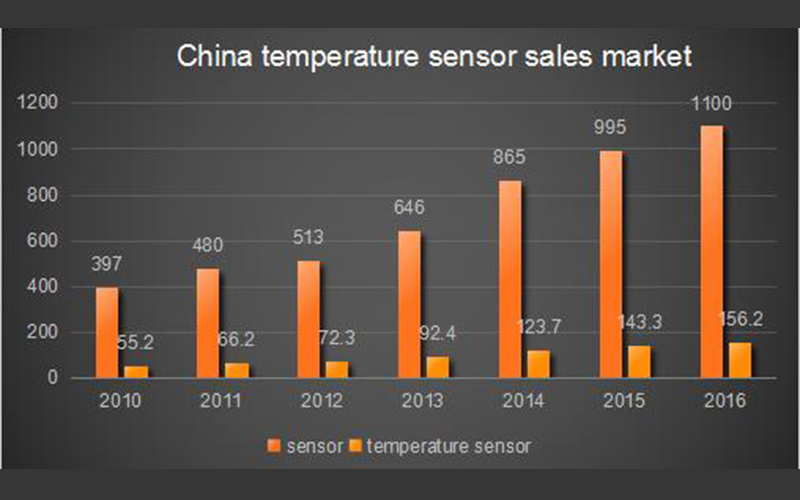Temperature sensor development prospects
1.Global market conditions
According to the MEMS Consulting Report, the global temperature market was US$5.13 billion in 2016, with a compound annual growth rate of 4.8% from 2016 to 2022. The market is expected to reach US$6.79 billion in 2022. In terms of shipments, the global temperature sensor market is expected to grow at double digits. The current demand for temperature sensors in the semiconductor industry, automotive industry, and some process industries is growing. This is due to the growing demand for sensing technology from industrial end users and the increasing vehicle production in economies such as Japan, India, and China. The report segments the global temperature sensor market by product type, end-user industry (including process industry, discrete industry, etc.), and region.
In terms of product type, temperature sensors based on thermocouple technology will occupy the largest market share. In terms of end users in the process industry, the chemical and petrochemical industries will occupy the largest market share. With the growth in the use of temperature sensors in the industrial field and the industry's increasing focus on safety and monitoring, it is expected that the process industry will account for 2016~2022. Dominate the temperature sensor market.

Among other discrete industries, the semiconductor industry will occupy the largest market share and dominate the temperature sensor market during 2016~2022. The Heating, Ventilation and Air Conditioning (HVAC) industry is expected to have the highest CAGR during the forecast period of this report. HVAC systems are widely used in commercial buildings such as offices and hotels.
North America will occupy the largest market share and dominate the temperature sensor market during 2016~2022. This is mainly due to: scientific research institutions in the region are increasingly using temperature sensors to study environmental changes in North America; the logistics and warehousing industry The use of temperature sensors continues to grow. In addition, the Asia-Pacific region is also full of potential growth opportunities.
2.China market size
Sensor technology, as the core means of collecting information, keeps pace with communication technology and computer technology and is an important pillar of modern information technology. It has had a profound impact on the development of the country's automation industry and the entire industrial construction process.
In today's information age, the first thing people have to solve is to obtain accurate and reliable information, and sensors are the main way and means to obtain information in the natural and production fields. Sensors have penetrated into fields such as industrial production, thermal energy measurement, space development, ocean exploration, environmental protection, resource surveys, medical diagnosis, bioengineering and even cultural relic protection, playing a positive role in promoting economic development and social progress.
From the perspective of application fields, the mechanical industry, automotive electronics, communication electronics, and consumer electronics are the largest markets for sensors. Sensors in the domestic industrial and automotive electronics fields account for about 42%, and the fastest growing are the automotive electronics and communication electronics application markets.

In recent years, the domestic sensor market has continued to grow rapidly, with an average annual growth rate of more than 20%. At present, there are more than 1,700 companies engaged in sensor production and research and development in my country, and the market size reached 86.5 billion yuan in 2014 and 99.5 billion yuan in 2015. Among them, the scale of the pressure sensor industry is approximately 19.4 billion yuan, accounting for approximately 19.5%; the scale of the flow sensor industry is approximately 21.19 billion yuan, accounting for approximately 21.3%; the scale of the temperature sensor industry is approximately 14.33 billion yuan, accounting for approximately 14.4%.
Calculated based on an annual growth rate of 20%, the domestic temperature sensor market size in 2018 can be predicted to be approximately 22.5 billion: The sales market situation of my country's temperature sensor industry in recent years is shown in the figure below:

3. Development trend
In the past century, the development of temperature sensors has generally gone through the following three stages:
1) Traditional discrete temperature sensor (including sensitive components)
2) Analog integrated temperature sensor/controller
3) Intelligent temperature sensor
"Currently, temperature sensors worldwide are undergoing a major transformation from analog to digital, integrated to intelligent and networked."











